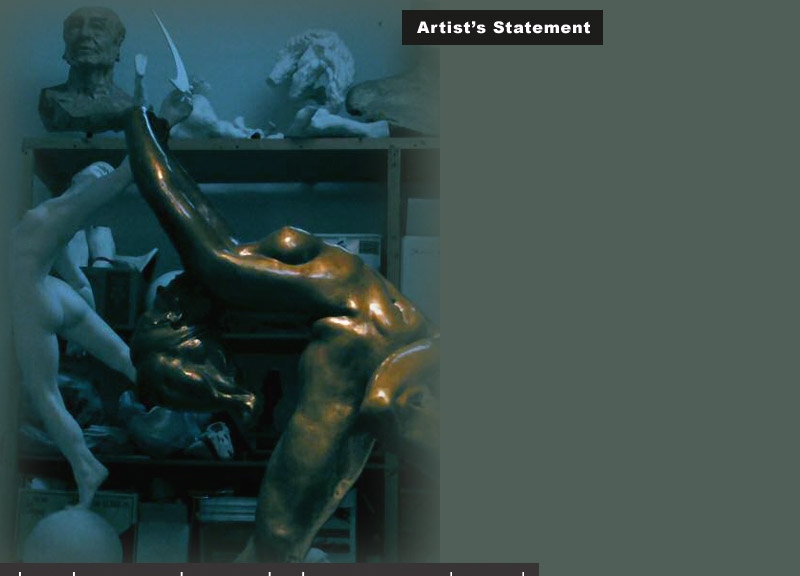
I have been asked many questions about my sculpture and by many different people. I find that my answers inevitably migrate to the very genesis of the sculpture in question. This being the case, I thought it best to, “begin at the beginning,” and describe certain events that take place behind the physical act of applying clay to an armature. I’ll attempt to give you a peek at the genie inside the bottle. I hope this approach offers a better understanding of my work and of my creative process. For me, the creation of art has become a form of prayer. I begin a sculpture by first getting outside of my functional self. I then direct my determination toward a creative impulse, which can be either predetermined or arbitrary. With clay, I begin searching, in three-dimensional space, for a link between impulse and form. This phase often becomes a struggle and requires patience. It involves unifying mind and matter by means of forming a visual language for an abstract thought. However, something unique occurs within that struggle. At some point I encounter a guiding energy that reaches from beyond the familiar. I place all my trust in it and under its influence I put things into a specific order. It is as though a third party joins the project and it is here that the image acquires its unique form. During this phase of the process, only intermittently will I step back and, seemingly alone, make aesthetic or functional decisions. I depend upon this guiding energy to lead me to creative places I would never find on my own. Throughout the entire process it is vital to continually preserve that which emerged from this early phase. Usually, after the work becomes established in its medium I am left to my intellect and cunning to exercise reconfiguration and refinement. The French artist Edgar Degas amusingly described this part of the creative process when he said, “As much knavery, malice and vice go into the making of a painting as into the perpetration of a crime.” At this stage of creativity I am careful not to impose excessive influence on the work. Things like cleverness, contemporary trends or decoration have an immediate appeal but are not always universal in their nature. They can easily distract from the work or neutralize what I refer to as, the independent life, of the work of art. It is a life that is universal and offers timeless relevance to the human psyche. Finally, I review expressiveness, balance, and proportions, making temporary adjustments. If I can do no more to enhance them without altering the work as a whole, then the work is finished. My creative process began to take place after years of studio work but it took almost two decades before I fully comprehended it. Without question, the process requires a childlike open- mindedness but above all persistence. Creative energy affects my work in profound ways; most importantly it gives it the universality I previously mentioned. I’m sure that my images would not transcend reality if left simply to my personality, intellect, and skill, although these devices do play an important role in my completed work. The presence of this energy gives me an opportunity to experience a potentiality far beyond my self-defined existence. Each work I create becomes a personal journey on behalf of humanity. Each journey offers a better understanding of myself as both an artist and a spiritual being. My primary medium for this experience is modeling clay and it is the human form that inspires me. I feel it is important to explain my creative process because in its conclusion dwells it’s beginning. This paradox has important significance. The art that I create is a kind of by-product of this process but uniquely inherent in this by-product is the energy that guided my creation of it. If it is present in the process it more than likely remains present in the finished work. In the arts, this energy is sometimes referred to as the spirit of the work. It is this spirit which differentiates, within aesthetics, a purely arbitrary, functional or clever object from an art object. But ultimately and more importantly, this manifest spirit presents the viewer an opportunity, as it did the artist, to experience the, “ field of infinite potentiality,” to use a phrase of the author D. Chopra. Perhaps this is why certain art objects created by mankind throughout the ages have been treasured and preserved. It is not so much what they represent as it is what metaphysical opportunity they offer. In conclusion, I feel an obligation to place the relevance of all this in a social context of goals and missions. Although we live in a world of high technology and electronic communication we must not forget that we remain creatures of the Earth and we begin each day and each thought from that premise. My mission then, is simply to preserve the efficacy of moist clay as a creative medium immune to worldly progress. We are not living in an artistically advanced society. At any time, the creation of art becomes a testament to the presence of spirit in mankind. My goal is the artistic exploration into the vast complexity of human nature in a way that brings figurative sculpture into the twenty-first century not as a tradition but as an affirmation that the fundamental aspects of being human are not a thing of the past. Edward Trobec |
 |
||||||||||||
|
|
|
|
|
|
|
|
|
|
|
|
|
|
|
|
|
|
|
|
|
|||||||